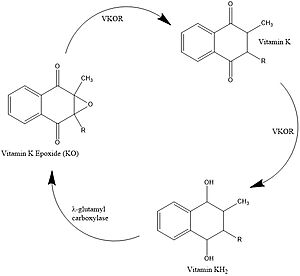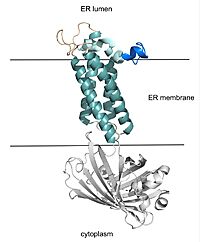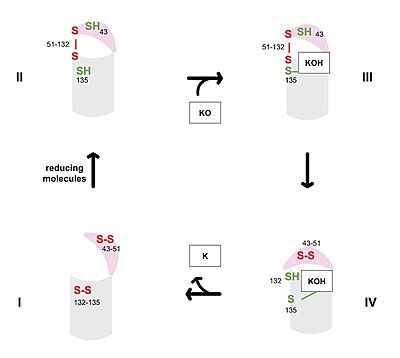Sandbox Reserved 1725
From Proteopedia
(Difference between revisions)
| Line 8: | Line 8: | ||
[[Image:barrel_domain_smaller.jpg|200 px|right|thumb|Figure 2. VKOR with Barrel Domain]] | [[Image:barrel_domain_smaller.jpg|200 px|right|thumb|Figure 2. VKOR with Barrel Domain]] | ||
=== Vitamin K Cycle === | === Vitamin K Cycle === | ||
| - | Vitamin K is essential for blood clotting in the body. The fully reduced form, KH2, allows the gamma carboxylation of blood clotting cofactors and is turned into the epoxide form in the process. Vitamin K epoxide reductase, abbreviated VKOR, turns the epoxide back to the fully reduced form so the reduced form can be used again. This transformation happens in two steps including converting the epoxide to the partially oxidized Vitamin K quinone then converting the quinone to the fully reduced hydroquinone (KH2). <ref name="Stafford">PMID:16102054</ref> | + | [https://en.wikipedia.org/wiki/Vitamin_K Vitamin K] is essential for blood clotting in the body. The fully reduced form, KH2, allows the gamma carboxylation of blood clotting cofactors and is turned into the epoxide form in the process. Vitamin K epoxide reductase, abbreviated VKOR, turns the epoxide back to the fully reduced form so the reduced form can be used again. This transformation happens in two steps including converting the epoxide to the partially oxidized Vitamin K quinone then converting the quinone to the fully reduced hydroquinone (KH2). <ref name="Stafford">PMID:16102054</ref> |
| + | |||
=== Structural Overview === | === Structural Overview === | ||
| - | |||
VKOR consists of four <scene name='90/904330/Transmembranehelices1/1'>transmembrane helices</scene> embedded in the endoplasmic reticulum membrane. The files on the RCSB Protein Data Bank include a barrel domain that is not pertinent to the function of VKOR. The images presented here have been edited to remove the barrel domain and renumbered to correspond with the article by Liu. <ref name="Liu">PMID:33154105</ref>. The original image with the barrel domain in context is shown in Figure 2. Helices one and two are connected by the <scene name='90/904330/Betahairpin2/1'>beta hairpin</scene> region which contains two of the active cysteines, C43 and C51. VKOR also has a <scene name='90/904330/Capdomain/1'>cap domain</scene> covering the active site, made up of an <scene name='90/904330/Capanchor/1'>anchor</scene>, <scene name='90/904330/Caploop/1'>loop</scene>, and <scene name='90/904330/Caphelix/1'>helix</scene>. | VKOR consists of four <scene name='90/904330/Transmembranehelices1/1'>transmembrane helices</scene> embedded in the endoplasmic reticulum membrane. The files on the RCSB Protein Data Bank include a barrel domain that is not pertinent to the function of VKOR. The images presented here have been edited to remove the barrel domain and renumbered to correspond with the article by Liu. <ref name="Liu">PMID:33154105</ref>. The original image with the barrel domain in context is shown in Figure 2. Helices one and two are connected by the <scene name='90/904330/Betahairpin2/1'>beta hairpin</scene> region which contains two of the active cysteines, C43 and C51. VKOR also has a <scene name='90/904330/Capdomain/1'>cap domain</scene> covering the active site, made up of an <scene name='90/904330/Capanchor/1'>anchor</scene>, <scene name='90/904330/Caploop/1'>loop</scene>, and <scene name='90/904330/Caphelix/1'>helix</scene>. | ||
== Catalytic Cycle == | == Catalytic Cycle == | ||
| - | |||
| - | ===Overview=== | ||
| - | There are 4 catalytic cysteines that are important to VKOR, 43, 51, 132, and 135. To explain how this works, it is easiest to start with the second state. In the second state, an oxidized or partially oxidized Vitamin K has entered the active site. The stabilizing 51-132 disulfide bond is shown. Then in the third state, 43 has attacked the disulfide bond and made its own bond with 51. You can see 132 has an oxygen. That is because the researchers made a mutation from S to O to force the reaction to stop at that step so the structure could be deduced. In the natural VKOR, that would be a sulfur. The next state, the open state, results from 132 forming a bridge with 135. This allows release of the reduced or partially reduced Vitamin K. All of this disulfide rearranging was working to reduce the Vitamin K, particularly in the 135 position. If we go back to State 2, when Vitamin K first binds, you can see that 135 is not tied up in a disulfide bond. It is available to help the Vitamin K bond. So, it makes sense that once 135 gets forced to bond, the now reduced Vitamin K is released. State 5 is interesting because the disulfide bonds are similar to the open state, but warfarin is actually bound. This represents the binding of warfarin to the fully oxidized VKOR at the end of its cycle. Going back to State 1, the researchers used a mutation at 43 to mimic VKOR’s partially oxidized state. Warfarin can also bind to this state and notice that the disulfide bonds are the same as State 2. Also it is worth pointing out how the disulfide bonds contribute to conformational changes and are affected by conformational changes, which affects their proximity to each other and the active site. | ||
===Catalytic Cysteines=== | ===Catalytic Cysteines=== | ||
| - | + | [[Image:Vkor_cat_cycle_jpeg.jpg|400 px|right|thumb|Figure 3. Catalytic Cycle of VKOR]] | |
| - | Warfarin binding also depends on the catalytic cysteines. Warfarin is able to bind to the fully oxidized form of VKOR | + | The catalytic cycle of VKOR includes transitions from open to closed conformations by means of disulfide bridge-induced conformational changes. The substituent cysteines (43, 51, 132, and 135) also act as reducing agents for the substrate, which can be either Vitamin K epoxide (KO) or partially reduced Vitamin K. The first step of the catalytic cycle (Figure 3) is the wild type open conformation, <scene name='90/904329/Cat_cycle_i/1'>step I</scene>. This step is characterized by an open cap domain with disulfide bonds between cysteines 43 and 51 and between cysteines 132 and 135. The second step of the catalytic cycle is a closed conformation, <scene name='90/904329/Cat_cycle_2/1'>step II</scene>. This step is characterized by a disulfide bond between the cap domain and alpha helices (Cys51 and Cys132), with both containing an SH group. The next step of the cycle, <scene name='90/904329/Cat_cycle_3/5'>step III</scene>, is also a closed structure with the same disulfide bond between Cys51 and Cys132. Cys135 is not involved in a disulfide bridge and assists with substrate binding. <scene name='90/904329/Cat_cycle_4/1'>step IV</scene> of the catalytic cycle is the last closed conformation. The Cys51-Cys132 bond is broken as Cys43 bonds with Cys51, recreating the disulfide bridge pattern of the open state. Cys132 is then free to bond with Cys135, releasing the product that was bound to the Cys135. The product will be either Vitamin K if the substrate was the epoxide or fully reduced Vitamin K hydroquinone if the substrate was Vitamin K. <ref name="Liu">PMID:33154105</ref> |
| + | |||
| + | The anticoagulant [https://en.wikipedia.org/wiki/Warfarin warfarin] works by inhibiting VKOR (See "Medical Relevance"). Warfarin binding also depends on the catalytic cysteines. Warfarin is able to bind to the fully oxidized open form of VKOR as shown in <scene name='90/904329/Cat_cycle_i/1'>step I</scene>. Once Warfarin binds, VKOR is considered to be in a closed conformation since the substrate cannot enter, despite the lack of disulfide bridge changes. Warfarin can also bind to the partially oxidized form of VKOR as shown in <scene name='90/904329/Cat_cycle_2/1'>step II</scene>. | ||
=== Catalytic Amino Acids === | === Catalytic Amino Acids === | ||
| - | VKOR uses two catalytic amino acids, tyrosine 139 and asparagine 80, to stabilize <scene name='90/904329/Kohhbond/ | + | VKOR uses two catalytic amino acids, tyrosine 139 and asparagine 80, to stabilize <scene name='90/904329/Kohhbond/2'>vitamin K</scene> in all forms and <scene name='90/904329/Warfarinhbond/3'>vitamin K antagonists</scene>, such as Warfarin, in the binding pocket. Tyr139 and Asn80 hydrogen bond to carbonyl groups on both structures and stabilizes them within the binding pocket. |
=== Hydrophobic Interactions === | === Hydrophobic Interactions === | ||
| - | + | Other than the two previously mentioned hydrogen bonds (Tyr139 and Asn80), <scene name='90/904329/Kohhydrophobic/2'>vitamin K</scene> and <scene name='90/904329/Warfarinhydrophobic/1'>antagonists</scene> are bound in via hydrophobic interactions within the binding pocket of VKOR. Hydrophobic residues of VKOR such as Phe80, Phe87, and Tyr88, form a hydrophobic tunnel within the binding pocket. | |
== Medical Relevance == | == Medical Relevance == | ||
Revision as of 22:13, 30 March 2022
| This Sandbox is Reserved from February 28 through September 1, 2022 for use in the course CH462 Biochemistry II taught by R. Jeremy Johnson at the Butler University, Indianapolis, USA. This reservation includes Sandbox Reserved 1700 through Sandbox Reserved 1729. |
To get started:
More help: Help:Editing |
Vitamin K Epoxide Reductase
| |||||||||||
References
- ↑ Stafford DW. The vitamin K cycle. J Thromb Haemost. 2005 Aug;3(8):1873-8. doi: 10.1111/j.1538-7836.2005.01419.x. PMID:16102054 doi:http://dx.doi.org/10.1111/j.1538-7836.2005.01419.x
- ↑ 2.0 2.1 Liu S, Li S, Shen G, Sukumar N, Krezel AM, Li W. Structural basis of antagonizing the vitamin K catalytic cycle for anticoagulation. Science. 2020 Nov 5. pii: science.abc5667. doi: 10.1126/science.abc5667. PMID:33154105 doi:http://dx.doi.org/10.1126/science.abc5667
Student Contributors
Izabella Jordan, Emma Varness



